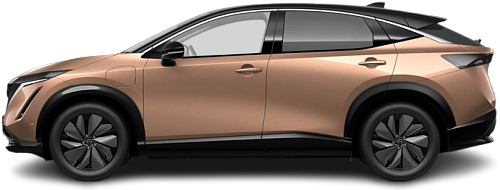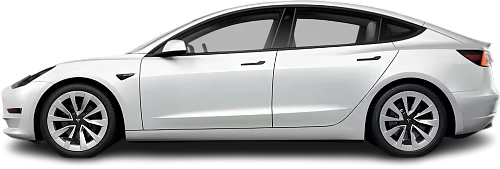Global EV Comparison: Nissan Ariya 87 kWh FWD vs Tesla Model 3 Standard Range
Struggling to Decide? Let AI Help!
Your AI Summary Is Ready!
General Info
The Nissan Ariya 87 kWh FWD (2021-…) is currently produced, it has a starting price of €53490. The Tesla Model 3 Standard Range (2019-2020) has been discontinued. You can find it for as low as €18790 on the used car market.
The Nissan Ariya 87 kWh FWD (2021-…) is a SUV, whereas the Tesla Model 3 Standard Range (2019-2020) is a Sedan.
| Property | Nissan Ariya 87 kWh FWD | Tesla Model 3 Standard Range |
|---|---|---|
| Years of Production | 2021-… | 2019-2020 |
| Current Status | Produced | Discontinued |
| Country of Manufacture | Japan, China | China, Germany, USA |
| Body Style | SUV | Sedan |
| Market Availability | EU, USA | EU, USA |
| Price Europe (New) | €53490 | - Price Europe (New) |
| Price Europe (Used) | €39898 | €18790 |
| GCC Score | 6.4 | 6.1 |
Range and Efficiency
While the Nissan Ariya 87 kWh FWD (2021-…) offers a longer real-world range and a bigger battery, it is less energy-efficient than the Tesla Model 3 Standard Range (2019-2020).
| Property | Nissan Ariya 87 kWh FWD | Tesla Model 3 Standard Range |
|---|---|---|
| Range (EPA) | 489 km | 354 km |
| Range (WLTP) | 536 km | - Range (WLTP) |
| Range (GCC) | 462 km | 336 km |
| Battery Capacity (Nominal) | 91 kWh | 60 kWh |
| Battery Capacity (Usable) | 87 kWh | 57.5 kWh |
| Efficiency per 100 km | 18.8 kWh/100 km | 17.1 kWh/100 km |
| Efficiency per kWh | 5.31 km/kWh | 5.84 km/kWh |
| Range and Efficiency Score | 7.3 | 6.2 |
Charging
Both vehicles utilize a standard 400-volt architecture.
The Tesla Model 3 Standard Range (2019-2020) offers faster charging speeds at DC stations, reaching up to 170 kW, while the Nissan Ariya 87 kWh FWD (2021-…) maxes out at 130 kW.
The Nissan Ariya 87 kWh FWD (2021-…) features a more powerful on-board charger, supporting a maximum AC charging power of 22 kW, whereas the Tesla Model 3 Standard Range (2019-2020) is limited to 11 kW.
| Property | Nissan Ariya 87 kWh FWD | Tesla Model 3 Standard Range |
|---|---|---|
| Max Charging Power (AC) | 22 kW | 11 kW |
| Max Charging Power (DC) | 130 kW | 170 kW |
| Architecture | 400 V | 400 V |
| Charge Port | CCS Type 2 | CCS Type 2 (Tesla) |
| Charging Score | 6.5 | 5.7 |
Performance
The Tesla Model 3 Standard Range (2019-2020) is rear-wheel drive, while the Nissan Ariya 87 kWh FWD (2021-…) offers a front-wheel drive system.
The Tesla Model 3 Standard Range (2019-2020) boasts greater motor power and accelerates faster from 0 to 100 km/h.
| Property | Nissan Ariya 87 kWh FWD | Tesla Model 3 Standard Range |
|---|---|---|
| Drive Type | FWD | RWD |
| Motor Type | EESM | PMSM |
| Motor Power (kW) | 178 kW | 208 kW |
| Motor Power (hp) | 239 hp | 279 hp |
| Motor Torque | 300 Nm | 420 Nm |
| 0-100 km/h | 7.6 s | 6.1 s |
| Top Speed | 160 km/h | 225 km/h |
| Performance Score | 3.5 | 5 |
Dimensions
The Tesla Model 3 Standard Range (2019-2020) has a longer body, while the Nissan Ariya 87 kWh FWD (2021-…) stands taller, offering a more elevated ride. Their widths are almost identical, so both offer a similar amount of shoulder room.
The Tesla Model 3 Standard Range (2019-2020) boasts a more extended wheelbase.
| Property | Nissan Ariya 87 kWh FWD | Tesla Model 3 Standard Range |
|---|---|---|
| Length | 4595 mm | 4695 mm |
| Width (with Mirrors) | 2172 mm | 2088 mm |
| Width (w/o Mirrors) | 1850 mm | 1850 mm |
| Height | 1660 mm | 1445 mm |
| Wheelbase | 2775 mm | 2875 mm |
Cargo and Towing
The Tesla Model 3 Standard Range (2019-2020) features a larger trunk, but the Nissan Ariya 87 kWh FWD (2021-…) offers greater maximum cargo capacity when the rear seats are folded.
A frunk (front trunk) is available in the Tesla Model 3 Standard Range (2019-2020), but the Nissan Ariya 87 kWh FWD (2021-…) doesn’t have one.
The Tesla Model 3 Standard Range (2019-2020) is better suited for heavy loads, offering a greater towing capacity than the Nissan Ariya 87 kWh FWD (2021-…).
| Property | Nissan Ariya 87 kWh FWD | Tesla Model 3 Standard Range |
|---|---|---|
| Number of Seats | 5 | 5 |
| Curb Weight | 2121 kg | 1611 kg |
| Cargo Volume (Trunk) | 466 l | 561 l |
| Cargo Volume (Max) | 1350 l | 1235 l |
| Cargo Volume (Frunk) | - Cargo Volume (Frunk) | 88 l |
| Towing Capacity | 750 kg | 1000 kg |
| Cargo and Towing Score | 6.8 | 5.1 |




